SWK785 Essay: Analyzing Social Work and Human Services Readings
VerifiedAdded on 2023/02/01
|9
|2584
|48
Essay
AI Summary
This essay provides a critical analysis of three key readings in social work: Germov (2014), McMurray and Clendon (2015), and Thompson (2011). The analysis begins by summarizing the significant insights of each reading, focusing on Germov's sociological perspective on health, McMurray and Clendon's community health and wellness, and Thompson's exploration of health as a social construct. The essay then delves into a critical examination of these readings, drawing connections between the authors' arguments and presenting the student's own developed thinking on the social determinants of health, health inequalities, and the role of social work in addressing these issues. The essay highlights the importance of understanding health within a broader social context, moving beyond biomedical models to consider the impact of social structures, community environments, and societal biases. The analysis emphasizes the necessity of social workers and health practitioners to advocate for social justice and human rights, promoting health literacy, and addressing health inequalities. The essay concludes by synthesizing the key concepts and arguments from the readings, offering a comprehensive overview of the complex relationship between health, society, and social work practice.
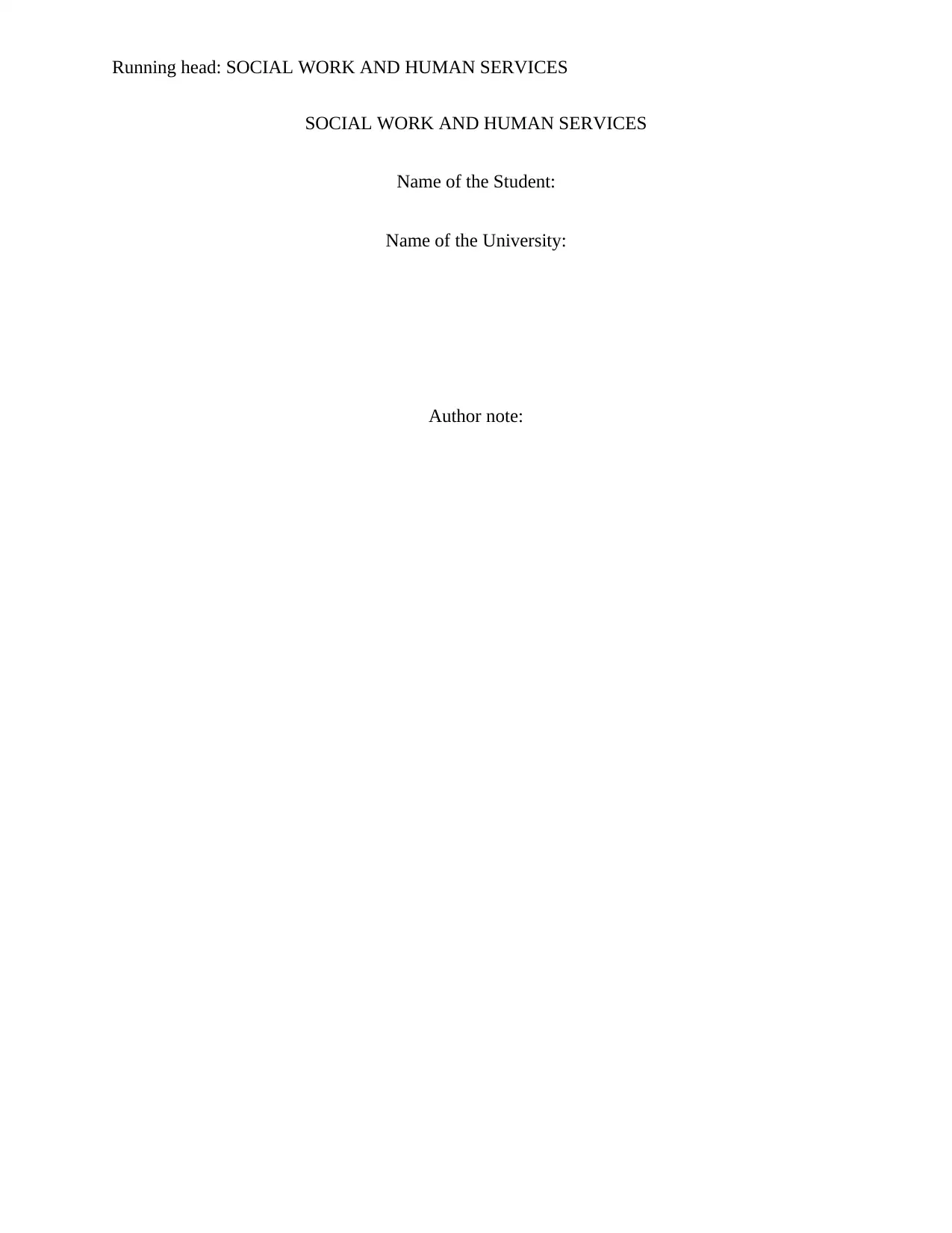
Running head: SOCIAL WORK AND HUMAN SERVICES
SOCIAL WORK AND HUMAN SERVICES
Name of the Student:
Name of the University:
Author note:
SOCIAL WORK AND HUMAN SERVICES
Name of the Student:
Name of the University:
Author note:
Paraphrase This Document
Need a fresh take? Get an instant paraphrase of this document with our AI Paraphraser
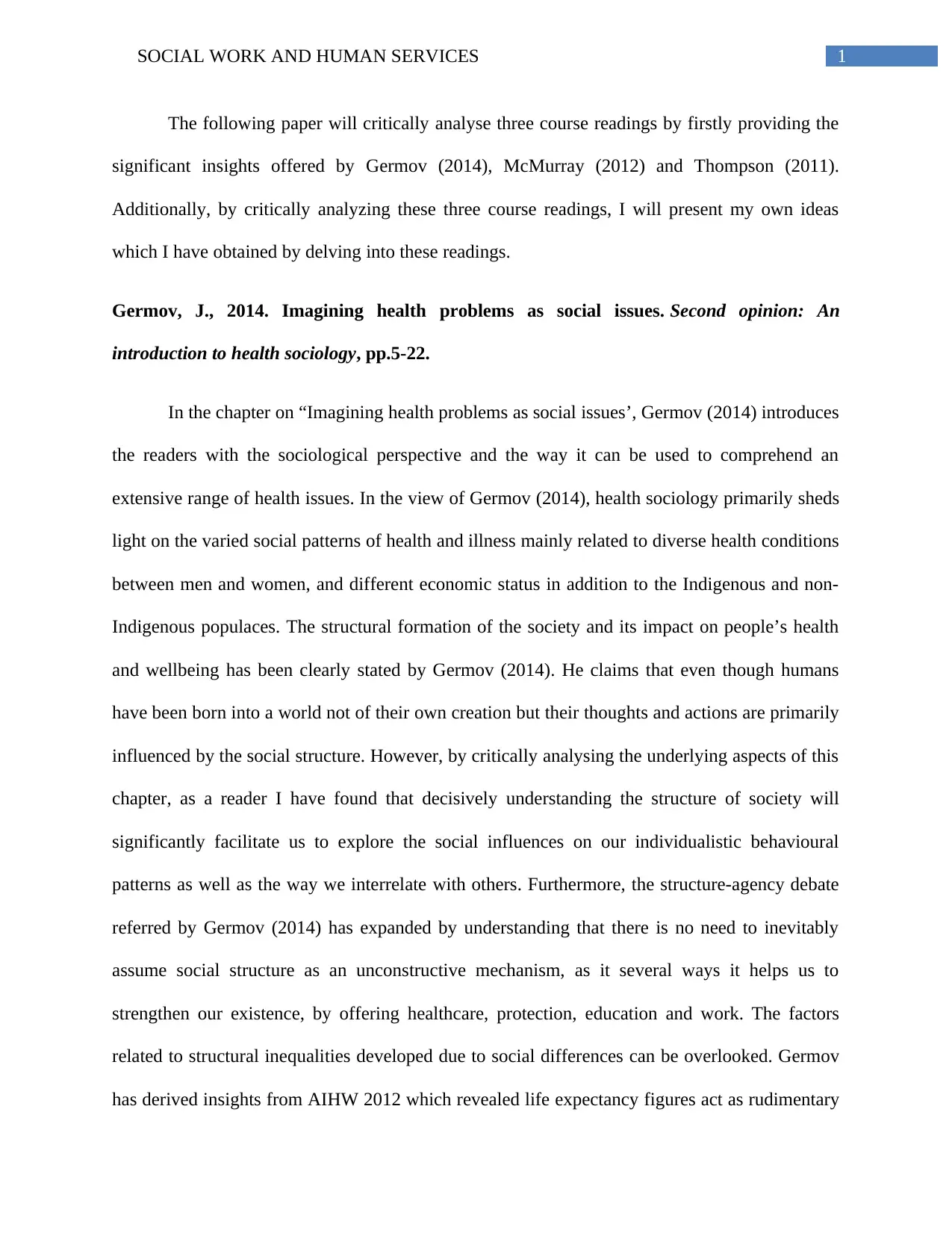
1SOCIAL WORK AND HUMAN SERVICES
The following paper will critically analyse three course readings by firstly providing the
significant insights offered by Germov (2014), McMurray (2012) and Thompson (2011).
Additionally, by critically analyzing these three course readings, I will present my own ideas
which I have obtained by delving into these readings.
Germov, J., 2014. Imagining health problems as social issues. Second opinion: An
introduction to health sociology, pp.5-22.
In the chapter on “Imagining health problems as social issues’, Germov (2014) introduces
the readers with the sociological perspective and the way it can be used to comprehend an
extensive range of health issues. In the view of Germov (2014), health sociology primarily sheds
light on the varied social patterns of health and illness mainly related to diverse health conditions
between men and women, and different economic status in addition to the Indigenous and non-
Indigenous populaces. The structural formation of the society and its impact on people’s health
and wellbeing has been clearly stated by Germov (2014). He claims that even though humans
have been born into a world not of their own creation but their thoughts and actions are primarily
influenced by the social structure. However, by critically analysing the underlying aspects of this
chapter, as a reader I have found that decisively understanding the structure of society will
significantly facilitate us to explore the social influences on our individualistic behavioural
patterns as well as the way we interrelate with others. Furthermore, the structure-agency debate
referred by Germov (2014) has expanded by understanding that there is no need to inevitably
assume social structure as an unconstructive mechanism, as it several ways it helps us to
strengthen our existence, by offering healthcare, protection, education and work. The factors
related to structural inequalities developed due to social differences can be overlooked. Germov
has derived insights from AIHW 2012 which revealed life expectancy figures act as rudimentary
The following paper will critically analyse three course readings by firstly providing the
significant insights offered by Germov (2014), McMurray (2012) and Thompson (2011).
Additionally, by critically analyzing these three course readings, I will present my own ideas
which I have obtained by delving into these readings.
Germov, J., 2014. Imagining health problems as social issues. Second opinion: An
introduction to health sociology, pp.5-22.
In the chapter on “Imagining health problems as social issues’, Germov (2014) introduces
the readers with the sociological perspective and the way it can be used to comprehend an
extensive range of health issues. In the view of Germov (2014), health sociology primarily sheds
light on the varied social patterns of health and illness mainly related to diverse health conditions
between men and women, and different economic status in addition to the Indigenous and non-
Indigenous populaces. The structural formation of the society and its impact on people’s health
and wellbeing has been clearly stated by Germov (2014). He claims that even though humans
have been born into a world not of their own creation but their thoughts and actions are primarily
influenced by the social structure. However, by critically analysing the underlying aspects of this
chapter, as a reader I have found that decisively understanding the structure of society will
significantly facilitate us to explore the social influences on our individualistic behavioural
patterns as well as the way we interrelate with others. Furthermore, the structure-agency debate
referred by Germov (2014) has expanded by understanding that there is no need to inevitably
assume social structure as an unconstructive mechanism, as it several ways it helps us to
strengthen our existence, by offering healthcare, protection, education and work. The factors
related to structural inequalities developed due to social differences can be overlooked. Germov
has derived insights from AIHW 2012 which revealed life expectancy figures act as rudimentary
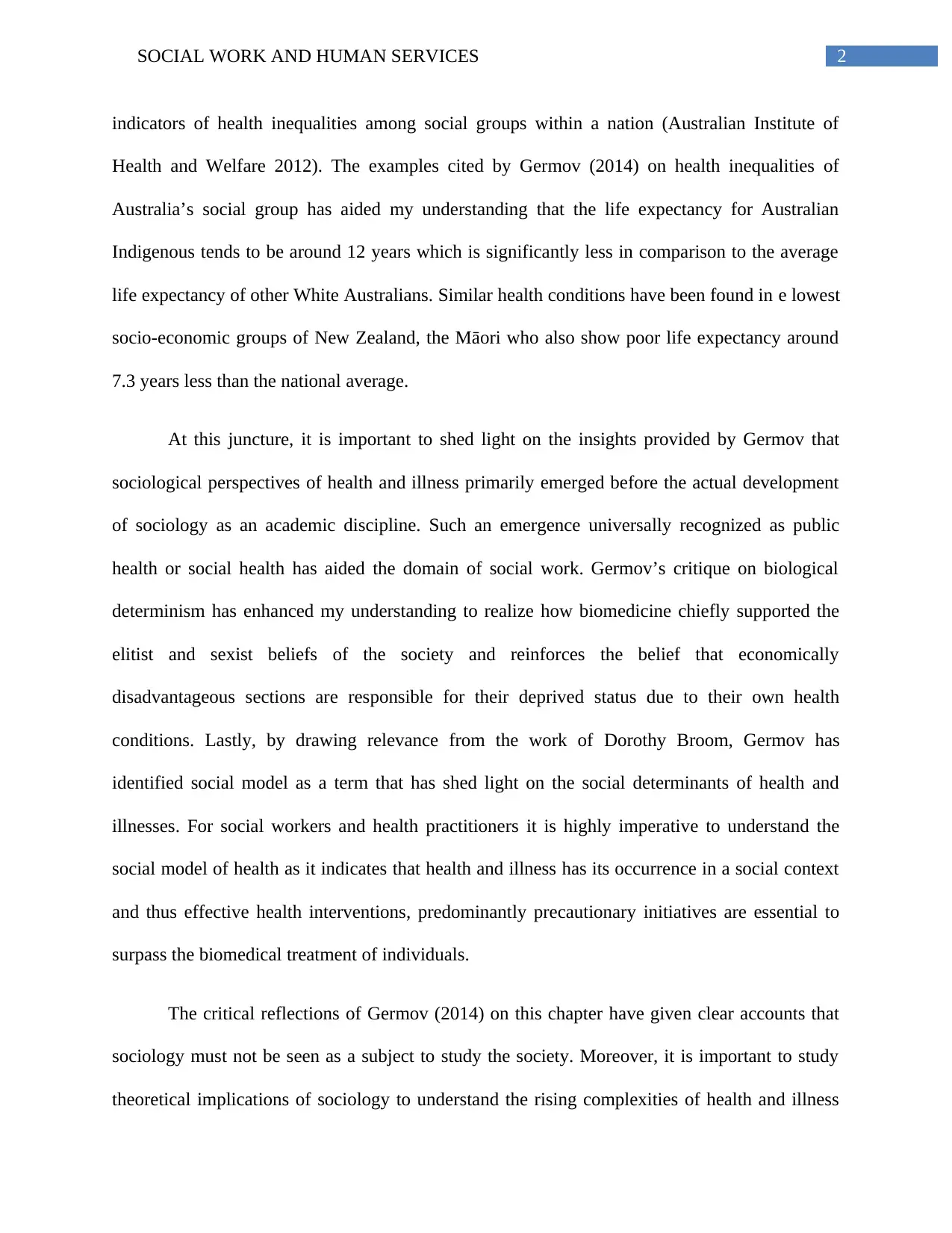
2SOCIAL WORK AND HUMAN SERVICES
indicators of health inequalities among social groups within a nation (Australian Institute of
Health and Welfare 2012). The examples cited by Germov (2014) on health inequalities of
Australia’s social group has aided my understanding that the life expectancy for Australian
Indigenous tends to be around 12 years which is significantly less in comparison to the average
life expectancy of other White Australians. Similar health conditions have been found in e lowest
socio-economic groups of New Zealand, the Māori who also show poor life expectancy around
7.3 years less than the national average.
At this juncture, it is important to shed light on the insights provided by Germov that
sociological perspectives of health and illness primarily emerged before the actual development
of sociology as an academic discipline. Such an emergence universally recognized as public
health or social health has aided the domain of social work. Germov’s critique on biological
determinism has enhanced my understanding to realize how biomedicine chiefly supported the
elitist and sexist beliefs of the society and reinforces the belief that economically
disadvantageous sections are responsible for their deprived status due to their own health
conditions. Lastly, by drawing relevance from the work of Dorothy Broom, Germov has
identified social model as a term that has shed light on the social determinants of health and
illnesses. For social workers and health practitioners it is highly imperative to understand the
social model of health as it indicates that health and illness has its occurrence in a social context
and thus effective health interventions, predominantly precautionary initiatives are essential to
surpass the biomedical treatment of individuals.
The critical reflections of Germov (2014) on this chapter have given clear accounts that
sociology must not be seen as a subject to study the society. Moreover, it is important to study
theoretical implications of sociology to understand the rising complexities of health and illness
indicators of health inequalities among social groups within a nation (Australian Institute of
Health and Welfare 2012). The examples cited by Germov (2014) on health inequalities of
Australia’s social group has aided my understanding that the life expectancy for Australian
Indigenous tends to be around 12 years which is significantly less in comparison to the average
life expectancy of other White Australians. Similar health conditions have been found in e lowest
socio-economic groups of New Zealand, the Māori who also show poor life expectancy around
7.3 years less than the national average.
At this juncture, it is important to shed light on the insights provided by Germov that
sociological perspectives of health and illness primarily emerged before the actual development
of sociology as an academic discipline. Such an emergence universally recognized as public
health or social health has aided the domain of social work. Germov’s critique on biological
determinism has enhanced my understanding to realize how biomedicine chiefly supported the
elitist and sexist beliefs of the society and reinforces the belief that economically
disadvantageous sections are responsible for their deprived status due to their own health
conditions. Lastly, by drawing relevance from the work of Dorothy Broom, Germov has
identified social model as a term that has shed light on the social determinants of health and
illnesses. For social workers and health practitioners it is highly imperative to understand the
social model of health as it indicates that health and illness has its occurrence in a social context
and thus effective health interventions, predominantly precautionary initiatives are essential to
surpass the biomedical treatment of individuals.
The critical reflections of Germov (2014) on this chapter have given clear accounts that
sociology must not be seen as a subject to study the society. Moreover, it is important to study
theoretical implications of sociology to understand the rising complexities of health and illness
⊘ This is a preview!⊘
Do you want full access?
Subscribe today to unlock all pages.

Trusted by 1+ million students worldwide
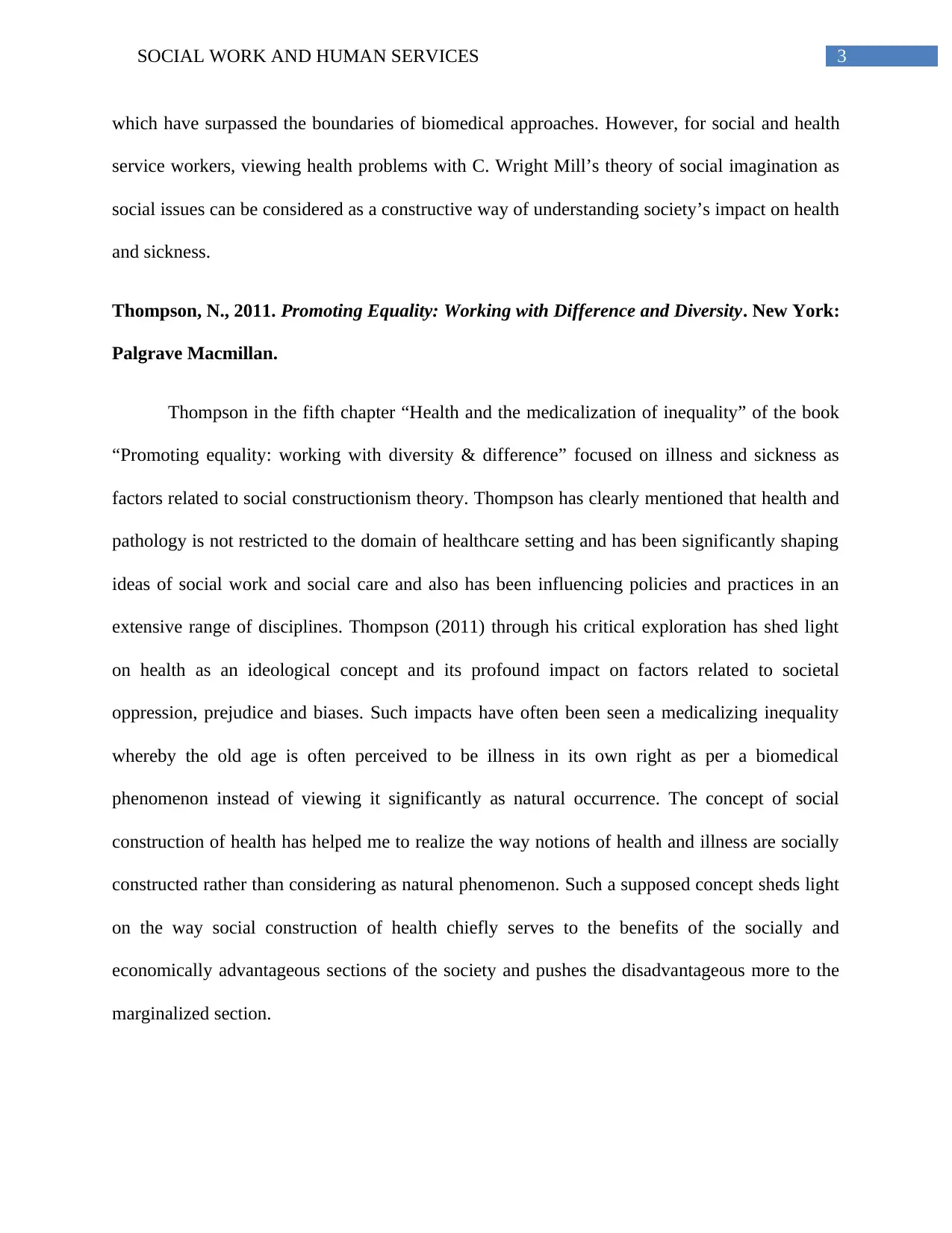
3SOCIAL WORK AND HUMAN SERVICES
which have surpassed the boundaries of biomedical approaches. However, for social and health
service workers, viewing health problems with C. Wright Mill’s theory of social imagination as
social issues can be considered as a constructive way of understanding society’s impact on health
and sickness.
Thompson, N., 2011. Promoting Equality: Working with Difference and Diversity. New York:
Palgrave Macmillan.
Thompson in the fifth chapter “Health and the medicalization of inequality” of the book
“Promoting equality: working with diversity & difference” focused on illness and sickness as
factors related to social constructionism theory. Thompson has clearly mentioned that health and
pathology is not restricted to the domain of healthcare setting and has been significantly shaping
ideas of social work and social care and also has been influencing policies and practices in an
extensive range of disciplines. Thompson (2011) through his critical exploration has shed light
on health as an ideological concept and its profound impact on factors related to societal
oppression, prejudice and biases. Such impacts have often been seen a medicalizing inequality
whereby the old age is often perceived to be illness in its own right as per a biomedical
phenomenon instead of viewing it significantly as natural occurrence. The concept of social
construction of health has helped me to realize the way notions of health and illness are socially
constructed rather than considering as natural phenomenon. Such a supposed concept sheds light
on the way social construction of health chiefly serves to the benefits of the socially and
economically advantageous sections of the society and pushes the disadvantageous more to the
marginalized section.
which have surpassed the boundaries of biomedical approaches. However, for social and health
service workers, viewing health problems with C. Wright Mill’s theory of social imagination as
social issues can be considered as a constructive way of understanding society’s impact on health
and sickness.
Thompson, N., 2011. Promoting Equality: Working with Difference and Diversity. New York:
Palgrave Macmillan.
Thompson in the fifth chapter “Health and the medicalization of inequality” of the book
“Promoting equality: working with diversity & difference” focused on illness and sickness as
factors related to social constructionism theory. Thompson has clearly mentioned that health and
pathology is not restricted to the domain of healthcare setting and has been significantly shaping
ideas of social work and social care and also has been influencing policies and practices in an
extensive range of disciplines. Thompson (2011) through his critical exploration has shed light
on health as an ideological concept and its profound impact on factors related to societal
oppression, prejudice and biases. Such impacts have often been seen a medicalizing inequality
whereby the old age is often perceived to be illness in its own right as per a biomedical
phenomenon instead of viewing it significantly as natural occurrence. The concept of social
construction of health has helped me to realize the way notions of health and illness are socially
constructed rather than considering as natural phenomenon. Such a supposed concept sheds light
on the way social construction of health chiefly serves to the benefits of the socially and
economically advantageous sections of the society and pushes the disadvantageous more to the
marginalized section.
Paraphrase This Document
Need a fresh take? Get an instant paraphrase of this document with our AI Paraphraser
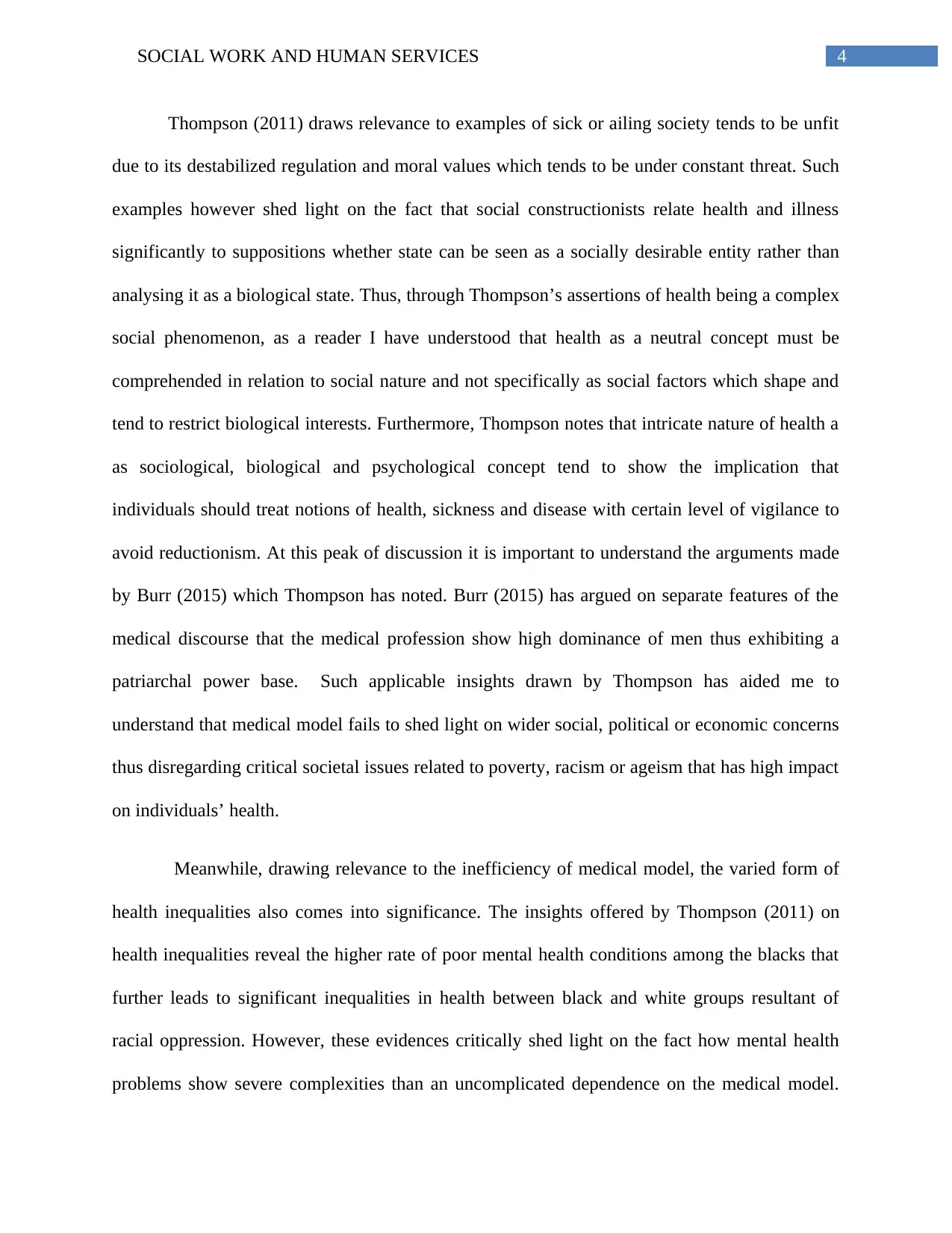
4SOCIAL WORK AND HUMAN SERVICES
Thompson (2011) draws relevance to examples of sick or ailing society tends to be unfit
due to its destabilized regulation and moral values which tends to be under constant threat. Such
examples however shed light on the fact that social constructionists relate health and illness
significantly to suppositions whether state can be seen as a socially desirable entity rather than
analysing it as a biological state. Thus, through Thompson’s assertions of health being a complex
social phenomenon, as a reader I have understood that health as a neutral concept must be
comprehended in relation to social nature and not specifically as social factors which shape and
tend to restrict biological interests. Furthermore, Thompson notes that intricate nature of health a
as sociological, biological and psychological concept tend to show the implication that
individuals should treat notions of health, sickness and disease with certain level of vigilance to
avoid reductionism. At this peak of discussion it is important to understand the arguments made
by Burr (2015) which Thompson has noted. Burr (2015) has argued on separate features of the
medical discourse that the medical profession show high dominance of men thus exhibiting a
patriarchal power base. Such applicable insights drawn by Thompson has aided me to
understand that medical model fails to shed light on wider social, political or economic concerns
thus disregarding critical societal issues related to poverty, racism or ageism that has high impact
on individuals’ health.
Meanwhile, drawing relevance to the inefficiency of medical model, the varied form of
health inequalities also comes into significance. The insights offered by Thompson (2011) on
health inequalities reveal the higher rate of poor mental health conditions among the blacks that
further leads to significant inequalities in health between black and white groups resultant of
racial oppression. However, these evidences critically shed light on the fact how mental health
problems show severe complexities than an uncomplicated dependence on the medical model.
Thompson (2011) draws relevance to examples of sick or ailing society tends to be unfit
due to its destabilized regulation and moral values which tends to be under constant threat. Such
examples however shed light on the fact that social constructionists relate health and illness
significantly to suppositions whether state can be seen as a socially desirable entity rather than
analysing it as a biological state. Thus, through Thompson’s assertions of health being a complex
social phenomenon, as a reader I have understood that health as a neutral concept must be
comprehended in relation to social nature and not specifically as social factors which shape and
tend to restrict biological interests. Furthermore, Thompson notes that intricate nature of health a
as sociological, biological and psychological concept tend to show the implication that
individuals should treat notions of health, sickness and disease with certain level of vigilance to
avoid reductionism. At this peak of discussion it is important to understand the arguments made
by Burr (2015) which Thompson has noted. Burr (2015) has argued on separate features of the
medical discourse that the medical profession show high dominance of men thus exhibiting a
patriarchal power base. Such applicable insights drawn by Thompson has aided me to
understand that medical model fails to shed light on wider social, political or economic concerns
thus disregarding critical societal issues related to poverty, racism or ageism that has high impact
on individuals’ health.
Meanwhile, drawing relevance to the inefficiency of medical model, the varied form of
health inequalities also comes into significance. The insights offered by Thompson (2011) on
health inequalities reveal the higher rate of poor mental health conditions among the blacks that
further leads to significant inequalities in health between black and white groups resultant of
racial oppression. However, these evidences critically shed light on the fact how mental health
problems show severe complexities than an uncomplicated dependence on the medical model.
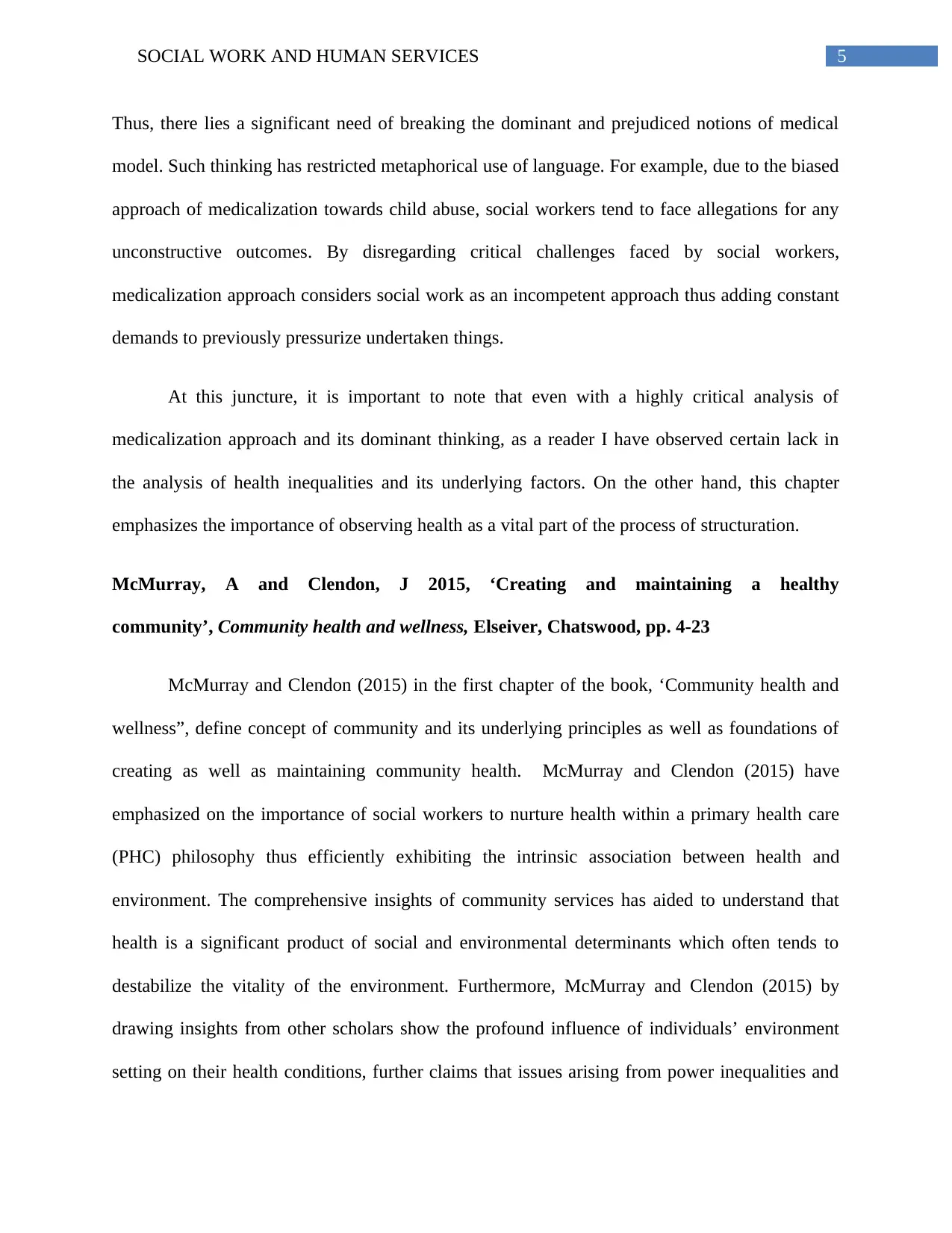
5SOCIAL WORK AND HUMAN SERVICES
Thus, there lies a significant need of breaking the dominant and prejudiced notions of medical
model. Such thinking has restricted metaphorical use of language. For example, due to the biased
approach of medicalization towards child abuse, social workers tend to face allegations for any
unconstructive outcomes. By disregarding critical challenges faced by social workers,
medicalization approach considers social work as an incompetent approach thus adding constant
demands to previously pressurize undertaken things.
At this juncture, it is important to note that even with a highly critical analysis of
medicalization approach and its dominant thinking, as a reader I have observed certain lack in
the analysis of health inequalities and its underlying factors. On the other hand, this chapter
emphasizes the importance of observing health as a vital part of the process of structuration.
McMurray, A and Clendon, J 2015, ‘Creating and maintaining a healthy
community’, Community health and wellness, Elseiver, Chatswood, pp. 4-23
McMurray and Clendon (2015) in the first chapter of the book, ‘Community health and
wellness”, define concept of community and its underlying principles as well as foundations of
creating as well as maintaining community health. McMurray and Clendon (2015) have
emphasized on the importance of social workers to nurture health within a primary health care
(PHC) philosophy thus efficiently exhibiting the intrinsic association between health and
environment. The comprehensive insights of community services has aided to understand that
health is a significant product of social and environmental determinants which often tends to
destabilize the vitality of the environment. Furthermore, McMurray and Clendon (2015) by
drawing insights from other scholars show the profound influence of individuals’ environment
setting on their health conditions, further claims that issues arising from power inequalities and
Thus, there lies a significant need of breaking the dominant and prejudiced notions of medical
model. Such thinking has restricted metaphorical use of language. For example, due to the biased
approach of medicalization towards child abuse, social workers tend to face allegations for any
unconstructive outcomes. By disregarding critical challenges faced by social workers,
medicalization approach considers social work as an incompetent approach thus adding constant
demands to previously pressurize undertaken things.
At this juncture, it is important to note that even with a highly critical analysis of
medicalization approach and its dominant thinking, as a reader I have observed certain lack in
the analysis of health inequalities and its underlying factors. On the other hand, this chapter
emphasizes the importance of observing health as a vital part of the process of structuration.
McMurray, A and Clendon, J 2015, ‘Creating and maintaining a healthy
community’, Community health and wellness, Elseiver, Chatswood, pp. 4-23
McMurray and Clendon (2015) in the first chapter of the book, ‘Community health and
wellness”, define concept of community and its underlying principles as well as foundations of
creating as well as maintaining community health. McMurray and Clendon (2015) have
emphasized on the importance of social workers to nurture health within a primary health care
(PHC) philosophy thus efficiently exhibiting the intrinsic association between health and
environment. The comprehensive insights of community services has aided to understand that
health is a significant product of social and environmental determinants which often tends to
destabilize the vitality of the environment. Furthermore, McMurray and Clendon (2015) by
drawing insights from other scholars show the profound influence of individuals’ environment
setting on their health conditions, further claims that issues arising from power inequalities and
⊘ This is a preview!⊘
Do you want full access?
Subscribe today to unlock all pages.

Trusted by 1+ million students worldwide
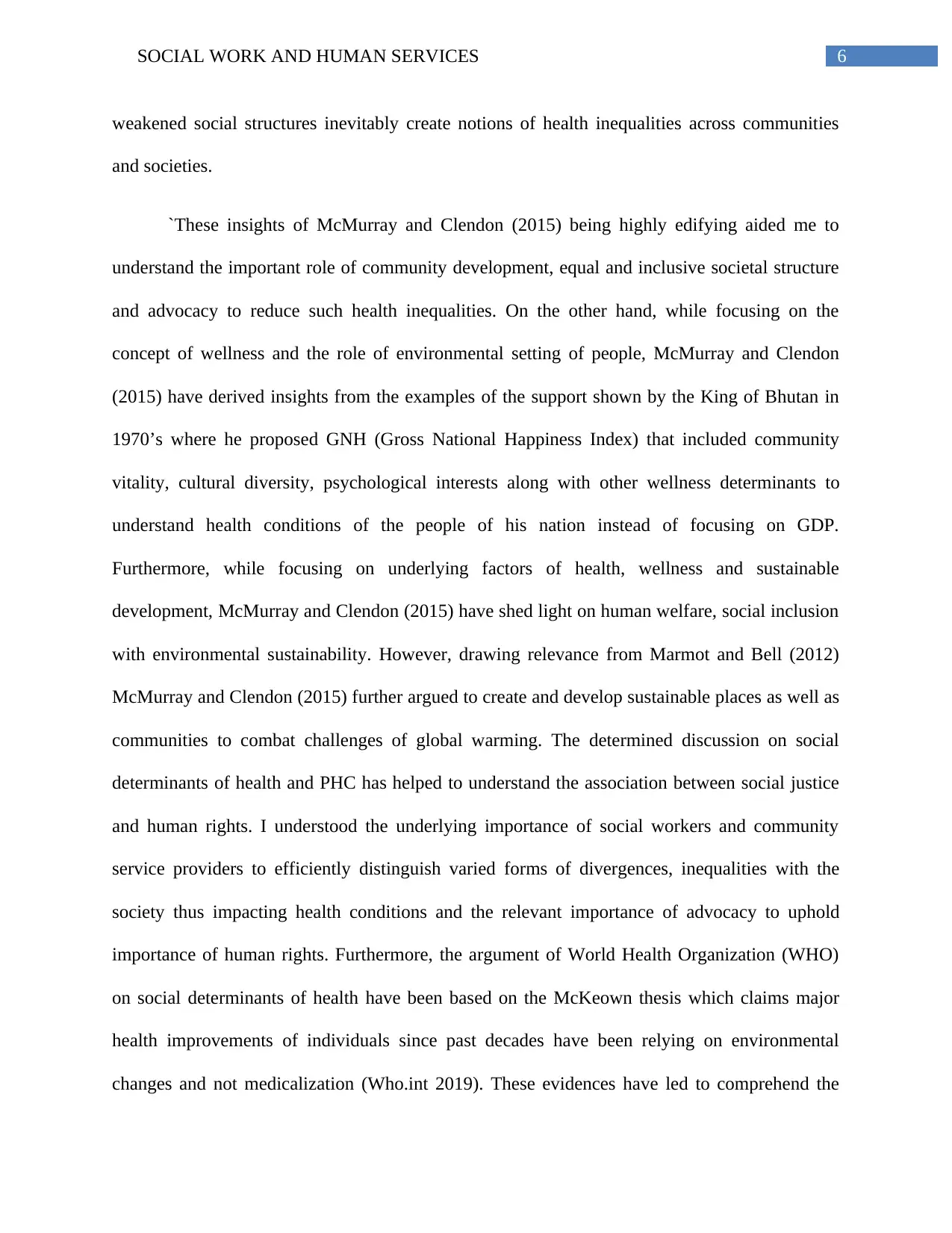
6SOCIAL WORK AND HUMAN SERVICES
weakened social structures inevitably create notions of health inequalities across communities
and societies.
`These insights of McMurray and Clendon (2015) being highly edifying aided me to
understand the important role of community development, equal and inclusive societal structure
and advocacy to reduce such health inequalities. On the other hand, while focusing on the
concept of wellness and the role of environmental setting of people, McMurray and Clendon
(2015) have derived insights from the examples of the support shown by the King of Bhutan in
1970’s where he proposed GNH (Gross National Happiness Index) that included community
vitality, cultural diversity, psychological interests along with other wellness determinants to
understand health conditions of the people of his nation instead of focusing on GDP.
Furthermore, while focusing on underlying factors of health, wellness and sustainable
development, McMurray and Clendon (2015) have shed light on human welfare, social inclusion
with environmental sustainability. However, drawing relevance from Marmot and Bell (2012)
McMurray and Clendon (2015) further argued to create and develop sustainable places as well as
communities to combat challenges of global warming. The determined discussion on social
determinants of health and PHC has helped to understand the association between social justice
and human rights. I understood the underlying importance of social workers and community
service providers to efficiently distinguish varied forms of divergences, inequalities with the
society thus impacting health conditions and the relevant importance of advocacy to uphold
importance of human rights. Furthermore, the argument of World Health Organization (WHO)
on social determinants of health have been based on the McKeown thesis which claims major
health improvements of individuals since past decades have been relying on environmental
changes and not medicalization (Who.int 2019). These evidences have led to comprehend the
weakened social structures inevitably create notions of health inequalities across communities
and societies.
`These insights of McMurray and Clendon (2015) being highly edifying aided me to
understand the important role of community development, equal and inclusive societal structure
and advocacy to reduce such health inequalities. On the other hand, while focusing on the
concept of wellness and the role of environmental setting of people, McMurray and Clendon
(2015) have derived insights from the examples of the support shown by the King of Bhutan in
1970’s where he proposed GNH (Gross National Happiness Index) that included community
vitality, cultural diversity, psychological interests along with other wellness determinants to
understand health conditions of the people of his nation instead of focusing on GDP.
Furthermore, while focusing on underlying factors of health, wellness and sustainable
development, McMurray and Clendon (2015) have shed light on human welfare, social inclusion
with environmental sustainability. However, drawing relevance from Marmot and Bell (2012)
McMurray and Clendon (2015) further argued to create and develop sustainable places as well as
communities to combat challenges of global warming. The determined discussion on social
determinants of health and PHC has helped to understand the association between social justice
and human rights. I understood the underlying importance of social workers and community
service providers to efficiently distinguish varied forms of divergences, inequalities with the
society thus impacting health conditions and the relevant importance of advocacy to uphold
importance of human rights. Furthermore, the argument of World Health Organization (WHO)
on social determinants of health have been based on the McKeown thesis which claims major
health improvements of individuals since past decades have been relying on environmental
changes and not medicalization (Who.int 2019). These evidences have led to comprehend the
Paraphrase This Document
Need a fresh take? Get an instant paraphrase of this document with our AI Paraphraser
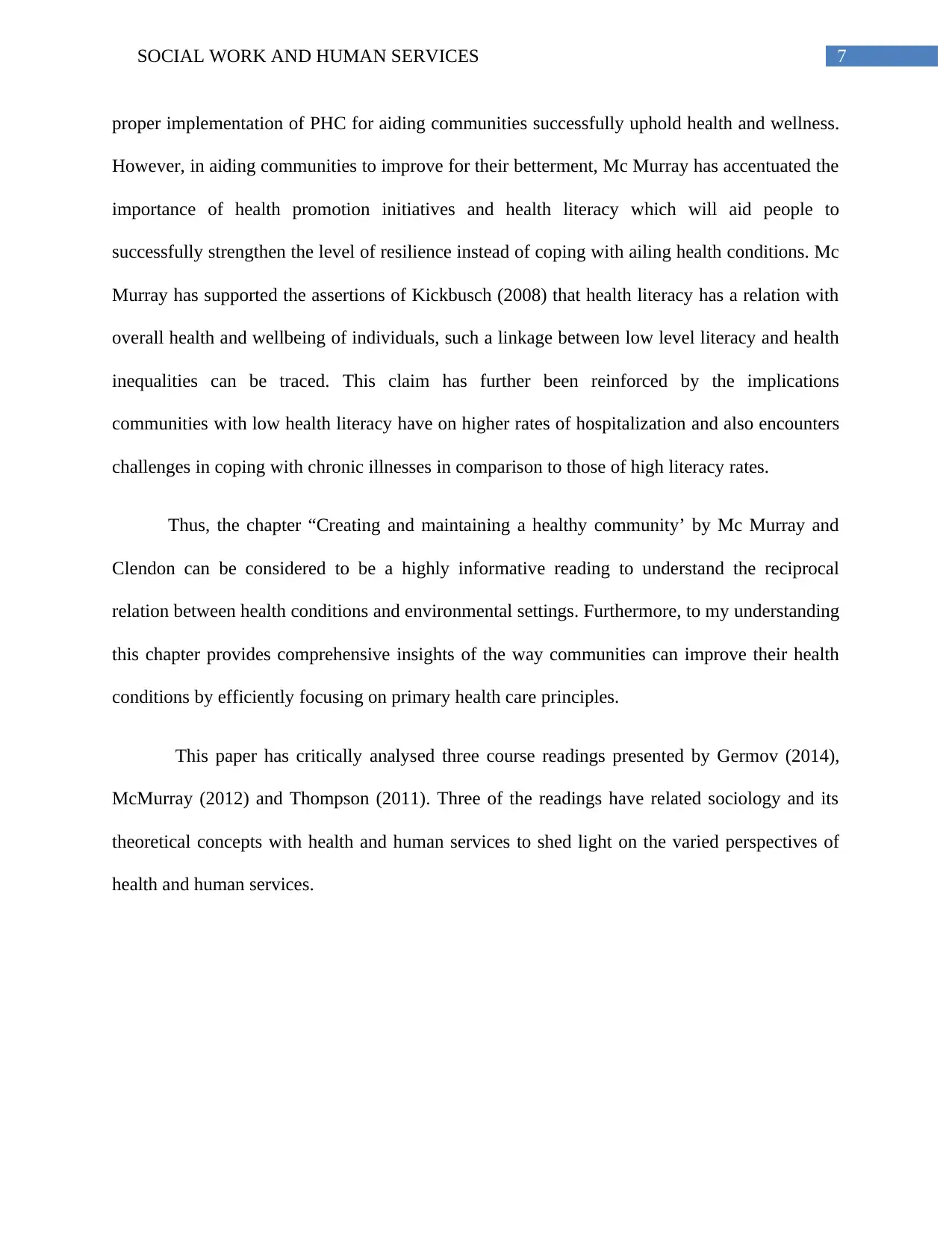
7SOCIAL WORK AND HUMAN SERVICES
proper implementation of PHC for aiding communities successfully uphold health and wellness.
However, in aiding communities to improve for their betterment, Mc Murray has accentuated the
importance of health promotion initiatives and health literacy which will aid people to
successfully strengthen the level of resilience instead of coping with ailing health conditions. Mc
Murray has supported the assertions of Kickbusch (2008) that health literacy has a relation with
overall health and wellbeing of individuals, such a linkage between low level literacy and health
inequalities can be traced. This claim has further been reinforced by the implications
communities with low health literacy have on higher rates of hospitalization and also encounters
challenges in coping with chronic illnesses in comparison to those of high literacy rates.
Thus, the chapter “Creating and maintaining a healthy community’ by Mc Murray and
Clendon can be considered to be a highly informative reading to understand the reciprocal
relation between health conditions and environmental settings. Furthermore, to my understanding
this chapter provides comprehensive insights of the way communities can improve their health
conditions by efficiently focusing on primary health care principles.
This paper has critically analysed three course readings presented by Germov (2014),
McMurray (2012) and Thompson (2011). Three of the readings have related sociology and its
theoretical concepts with health and human services to shed light on the varied perspectives of
health and human services.
proper implementation of PHC for aiding communities successfully uphold health and wellness.
However, in aiding communities to improve for their betterment, Mc Murray has accentuated the
importance of health promotion initiatives and health literacy which will aid people to
successfully strengthen the level of resilience instead of coping with ailing health conditions. Mc
Murray has supported the assertions of Kickbusch (2008) that health literacy has a relation with
overall health and wellbeing of individuals, such a linkage between low level literacy and health
inequalities can be traced. This claim has further been reinforced by the implications
communities with low health literacy have on higher rates of hospitalization and also encounters
challenges in coping with chronic illnesses in comparison to those of high literacy rates.
Thus, the chapter “Creating and maintaining a healthy community’ by Mc Murray and
Clendon can be considered to be a highly informative reading to understand the reciprocal
relation between health conditions and environmental settings. Furthermore, to my understanding
this chapter provides comprehensive insights of the way communities can improve their health
conditions by efficiently focusing on primary health care principles.
This paper has critically analysed three course readings presented by Germov (2014),
McMurray (2012) and Thompson (2011). Three of the readings have related sociology and its
theoretical concepts with health and human services to shed light on the varied perspectives of
health and human services.
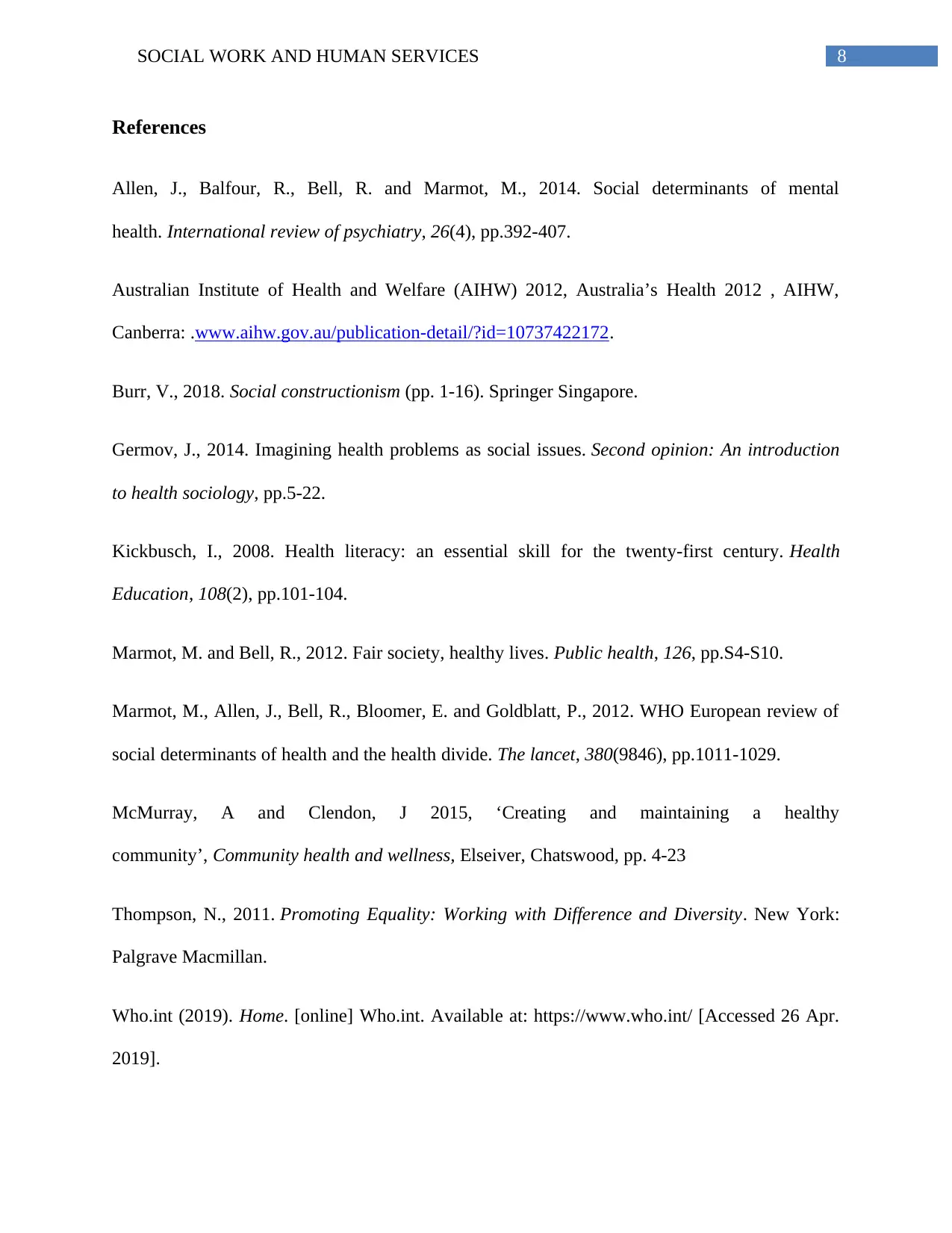
8SOCIAL WORK AND HUMAN SERVICES
References
Allen, J., Balfour, R., Bell, R. and Marmot, M., 2014. Social determinants of mental
health. International review of psychiatry, 26(4), pp.392-407.
Australian Institute of Health and Welfare (AIHW) 2012, Australia’s Health 2012 , AIHW,
Canberra: .www.aihw.gov.au/publication-detail/?id=10737422172.
Burr, V., 2018. Social constructionism (pp. 1-16). Springer Singapore.
Germov, J., 2014. Imagining health problems as social issues. Second opinion: An introduction
to health sociology, pp.5-22.
Kickbusch, I., 2008. Health literacy: an essential skill for the twenty-first century. Health
Education, 108(2), pp.101-104.
Marmot, M. and Bell, R., 2012. Fair society, healthy lives. Public health, 126, pp.S4-S10.
Marmot, M., Allen, J., Bell, R., Bloomer, E. and Goldblatt, P., 2012. WHO European review of
social determinants of health and the health divide. The lancet, 380(9846), pp.1011-1029.
McMurray, A and Clendon, J 2015, ‘Creating and maintaining a healthy
community’, Community health and wellness, Elseiver, Chatswood, pp. 4-23
Thompson, N., 2011. Promoting Equality: Working with Difference and Diversity. New York:
Palgrave Macmillan.
Who.int (2019). Home. [online] Who.int. Available at: https://www.who.int/ [Accessed 26 Apr.
2019].
References
Allen, J., Balfour, R., Bell, R. and Marmot, M., 2014. Social determinants of mental
health. International review of psychiatry, 26(4), pp.392-407.
Australian Institute of Health and Welfare (AIHW) 2012, Australia’s Health 2012 , AIHW,
Canberra: .www.aihw.gov.au/publication-detail/?id=10737422172.
Burr, V., 2018. Social constructionism (pp. 1-16). Springer Singapore.
Germov, J., 2014. Imagining health problems as social issues. Second opinion: An introduction
to health sociology, pp.5-22.
Kickbusch, I., 2008. Health literacy: an essential skill for the twenty-first century. Health
Education, 108(2), pp.101-104.
Marmot, M. and Bell, R., 2012. Fair society, healthy lives. Public health, 126, pp.S4-S10.
Marmot, M., Allen, J., Bell, R., Bloomer, E. and Goldblatt, P., 2012. WHO European review of
social determinants of health and the health divide. The lancet, 380(9846), pp.1011-1029.
McMurray, A and Clendon, J 2015, ‘Creating and maintaining a healthy
community’, Community health and wellness, Elseiver, Chatswood, pp. 4-23
Thompson, N., 2011. Promoting Equality: Working with Difference and Diversity. New York:
Palgrave Macmillan.
Who.int (2019). Home. [online] Who.int. Available at: https://www.who.int/ [Accessed 26 Apr.
2019].
⊘ This is a preview!⊘
Do you want full access?
Subscribe today to unlock all pages.

Trusted by 1+ million students worldwide
1 out of 9
Related Documents
Your All-in-One AI-Powered Toolkit for Academic Success.
+13062052269
info@desklib.com
Available 24*7 on WhatsApp / Email
![[object Object]](/_next/static/media/star-bottom.7253800d.svg)
Unlock your academic potential
Copyright © 2020–2025 A2Z Services. All Rights Reserved. Developed and managed by ZUCOL.





